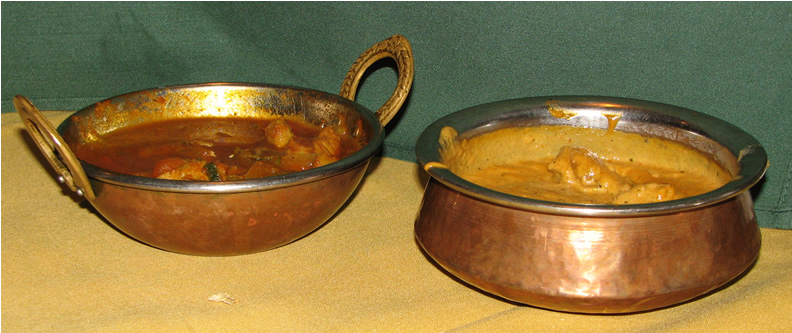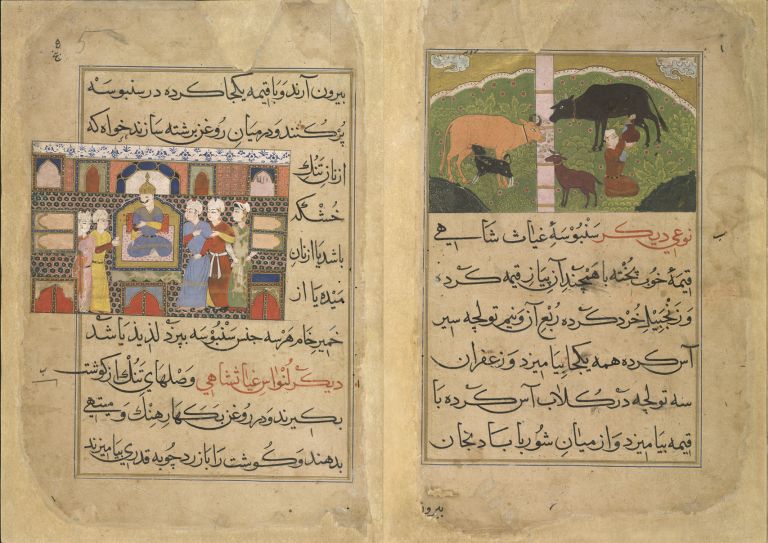|
Karahi
A ''karahi'' is a type of thick, circular, and deep cooking pot, similar in shape to a wok, from Northern South Asia. It is used in Indian cuisine, North Indian, Pakistani cuisine, Pakistani, Afghanistan cuisine, Afghan, Nepalese cuisine, Nepalese, and Caribbean cuisines. Traditionally press-formed from Carbon_steel#Mild_steel, mild steel sheets or made of wrought iron, a ''karahi'' is a wok with steeper sides. Today, they can be made of stainless steel, copper, and Non-stick surface, nonstick surfaces, both round and flat-bottomed, or of traditional materials. The word ''karahi'' emanates from ''karah'', a bigger version of karahi traditionally used in the subcontinent for boiling milk and producing Cream, thick cream. History ''Karahi'' or ''kadahi'' comes from the Prakrit word ''kataha'', which is mentioned in texts like the ''Ramayana'' and Sushruta Samhita, ''Sushruta Samhita'', and derives from Sanskrit ''kataha'' (meaning a frying pan, boiler, cauldron or saucepan). A ka ... [...More Info...] [...Related Items...] OR: [Wikipedia] [Google] [Baidu] |
Chicken Karahi
Chicken karahi, or kadai chicken, is a chicken dish from South Asia. It is known as gosht karahi when prepared with Goat meat, goat or Lamb and mutton, lamb meat instead of chicken. It is noted for its spicy taste and is notable in South Asian cuisine, South Asian Cuisine. The dish is prepared in a karahi (a type of wok) and can take between 30 and 50 minutes to prepare and cook the dish. Ginger, garlic, tomatoes, green chilli and coriander are key to the flavor of the dish. What distinguishes chicken karahi from other curries from the region is that traditionally, it is cooked without onions in the base, and instead uses just tomatoes, ginger and garlic. It is usually served with naan, roti or rice. This dish is common in North Indian and Pakistani cuisine. History Chicken Karahi traces its origin back to Pakistan's mountainous Khyber Pakhtunkhwa province (formerly called the North-West Frontier Province). References Indian chicken dishes Pakistani chicken di ... [...More Info...] [...Related Items...] OR: [Wikipedia] [Google] [Baidu] |
Pakistani Cuisine
Pakistani cuisine (, Roman Urdu, romanized: ''pākistānī pakwān'') is a blend of regional cooking styles and flavours from across South Asia, South, Central Asia, Central and West Asia. It is a culmination of Iranic, Indic & Arab culinary traditions. The cuisine of Pakistan also maintains certain Mughal Empire, Mughal influences within its recipes and cooking techniques, particularly the use of dried fruits and nuts. Pakistan's Ethnic groups in Pakistan, ethnic and Culture of Pakistan, cultural diversity, diverse climates, geographical environments, and availability of different produce lead to diverse regional cuisines. Pakistani cuisine, like the culinary traditions of most Muslim-majority nations, adheres to ''halal'' principles in accordance with Islamic dietary laws, which prohibit the consumption of pork and alcohol, among other restrictions. Additionally, halal regulations outline specific guidelines for meat consumption, including which animals are considered permi ... [...More Info...] [...Related Items...] OR: [Wikipedia] [Google] [Baidu] |
Sanskrit
Sanskrit (; stem form ; nominal singular , ,) is a classical language belonging to the Indo-Aryan languages, Indo-Aryan branch of the Indo-European languages. It arose in northwest South Asia after its predecessor languages had Trans-cultural diffusion, diffused there from the northwest in the late Bronze Age#South Asia, Bronze Age. Sanskrit is the sacred language of Hinduism, the language of classical Hindu philosophy, and of historical texts of Buddhism and Jainism. It was a lingua franca, link language in ancient and medieval South Asia, and upon transmission of Hindu and Buddhist culture to Southeast Asia, East Asia and Central Asia in the early medieval era, it became a language of religion and high culture, and of the political elites in some of these regions. As a result, Sanskrit had a lasting effect on the languages of South Asia, Southeast Asia and East Asia, especially in their formal and learned vocabularies. Sanskrit generally connotes several Indo-Aryan languages# ... [...More Info...] [...Related Items...] OR: [Wikipedia] [Google] [Baidu] |
Stew
A stew is a combination of solid food ingredients that have been Cooking, cooked in Soup, liquid and served in the resultant gravy. Ingredients can include any combination of vegetables and may include meat, especially tougher meats suitable for slow-cooking, such as beef, pork, venison, Rabbit as food, rabbit, lamb and mutton, lamb, poultry, sausages, and seafood. While water can be used as the stew-cooking liquid, Stock (food), stock is also common. A small amount of red wine or other alcohol is sometimes added for flavour. Seasonings and flavourings may also be added. Stews are typically cooked at a relatively low temperature (Simmering, simmered, not Boiling, boiled), allowing flavours to mingle. Stewing is suitable for the least tender cuts of meat that become tender and juicy with the slow, moist heat method. This makes it popular for low-cost cooking. Cuts with a certain amount of marbling and gelatinous connective tissue give moist, juicy stews, while lean meat may easily ... [...More Info...] [...Related Items...] OR: [Wikipedia] [Google] [Baidu] |
Papadam
A papadam (also spelled poppadom, among other variants), also known as papad, is a snack that originated in the Indian subcontinent. Dough of black gram bean flour is either deep fried or cooked with dry heat (flipped over an open flame) until crunchy. Other flours made from lentils, chickpeas, rice, tapioca, millet or potato are also used. Papadam is typically served as an accompaniment to a meal in India, Pakistan, Bangladesh, Nepal, Sri Lanka and the Caribbean or as an appetizer, often with a dip such as chutneys, or toppings such as chopped onions and chili peppers, or it may be used as an ingredient in curries. Etymology ''Papadam'' is a loanword from Tamil , and is likely to be derived from Sanskrit , meaning a flattened disc described in early Jain and Buddhist literature. Papad is known by several names in the various languages of India, e.g. in Hindi; in Telugu; or in Tamil; in Kannada; in Sinhala; in Malayalam; in Marathi; in Punjabi; ... [...More Info...] [...Related Items...] OR: [Wikipedia] [Google] [Baidu] |
Samosa
A samosa () () (Hindi: समोसा) ( Persian: سمبوسه) is a fried South Asian and West Asian snack. It is a pastry with a savory filling that mostly consists of vegetables like spiced potatoes, onions, and peas, but can also include meat or fish, or even cheese. Its name originates from the Persian word sambosag (''سنبوسگ'') (meaning 'triangular pastry'). It is made in different shapes, including triangular, cone, or crescent, depending on the region. Samosas are often accompanied by chutney, and have origins in medieval times or earlier. Sweet versions are also made. Samosas are a popular entrée, appetizer, or snack in the cuisines of India, South Asia, Southeast Asia, West Asia, Central Asia, Portugal, East Africa and their South Asian diasporas. Etymology The English word ''samosa'' derives from the Hindustani word (, ), traceable to the Middle Persian word () [...More Info...] [...Related Items...] OR: [Wikipedia] [Google] [Baidu] |
Deep Frying
Deep frying (also referred to as deep fat frying) is a cooking method in which food is submerged in hot fat, traditionally lard but today most commonly Cooking oil, oil, as opposed to the shallow frying used in conventional frying done in a frying pan. Normally, a deep fryer or chip pan is used for this; industrially, a pressure fryer or vacuum fryer may be used. Deep frying may also be performed using oil that is heated in a pot. Deep frying is classified as a hot-fat cooking method. Typically, deep frying foods cook quickly since oil has a high rate of heat conduction and all sides of the food are cooked simultaneously. The term "deep frying" and many modern deep-fried foods were not invented until the 19th century, but the practice has been around for millennia. Early records and cookbooks suggest that the practice began in certain European countries before other countries adopted the practice. Deep frying is popular worldwide, with deep-fried foods accounting for a large por ... [...More Info...] [...Related Items...] OR: [Wikipedia] [Google] [Baidu] |
Shallow Frying
Shallow frying is a hot oil-based cooking technique. Pieces of food are cooked by partial submersion in hot oil. It is typically used to prepare portion-sized cuts of meat, fish, potatoes and patties such as fritters. Shallow frying can also be used to cook vegetables. Shallow frying is distinct from deep frying, which uses enough oil to fully submerge the food to be cooked, and pan frying, which only uses a negligible depth of oil. Technique It is a medium-high to high heat cooking process. Temperatures between are typical, but shallow frying may be performed at temperatures as low as for a longer period of time. The high heat promotes protein denaturation- browning and, in some cases, a Maillard reaction. Deep frying usually takes place at temperatures between so shallow-frying can oftentimes be considered a less intense cooking technique. Foods to be shallow fried are commonly pre-portioned into single servings before being placed in oil. Since the food is only partly s ... [...More Info...] [...Related Items...] OR: [Wikipedia] [Google] [Baidu] |
Fried Eggs (25056120628)
A fried egg is a cooked dish made from one or more Egg (food), eggs which are removed from their shells and placed into a frying pan and cooked. They are traditionally eaten for breakfast or brunch in many countries but may also be served at other times of the day. Regional adaptations and specialities Austria, Germany, and Switzerland Fried eggs ('; singular ') are a crucial part of such traditional German dishes as ' (the egg is fried on one side with an unbroken yolk, and served "sunny side up" atop an open ham sandwich) or ' / ' / ''Fernfahrerschnitzel'' ("trucker's schnitzel") – a similarly prepared fried egg served on a '. Fried eggs over (or side-by-side with) pan-fried potatoes is another common dish, sometimes served with spinach as a third component of the meal. Some German cooks break the yolk and distribute it across the surface of the Egg white, white during the frying. All of the above are typically lunch, rather than breakfast, dishes, although eggs the ... [...More Info...] [...Related Items...] OR: [Wikipedia] [Google] [Baidu] |
Vedas
FIle:Atharva-Veda samhita page 471 illustration.png, upright=1.2, The Vedas are ancient Sanskrit texts of Hinduism. Above: A page from the ''Atharvaveda''. The Vedas ( or ; ), sometimes collectively called the Veda, are a large body of religious texts originating in ancient India. Composed in Vedic Sanskrit, the texts constitute the oldest layer of Sanskrit literature and the oldest Hindu texts, scriptures of Hinduism. There are four Vedas: the Rigveda, the Yajurveda, the Samaveda and the Atharvaveda. Each Veda has four subdivisions – the Samhitas (mantras and benedictions), the Brahmanas (commentaries on and explanation of rituals, ceremonies and sacrifices – Yajñas), the Aranyakas (text on rituals, ceremonies, sacrifices and symbolic-sacrifices), and the Upanishads (texts discussing meditation, philosophy and spiritual knowledge).Gavin Flood (1996), ''An Introduction to Hinduism'', Cambridge University Press, , pp. 35–39A Bhattacharya (2006), ''Hindu Dharma: Introduc ... [...More Info...] [...Related Items...] OR: [Wikipedia] [Google] [Baidu] |






